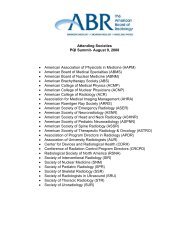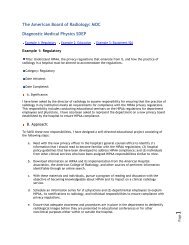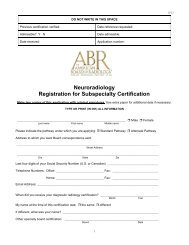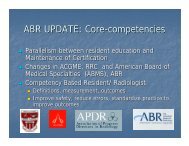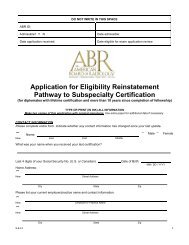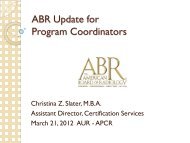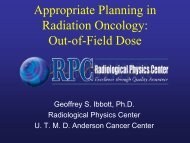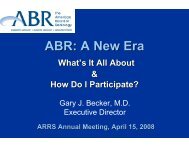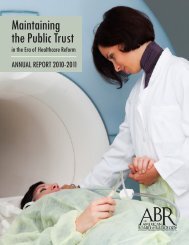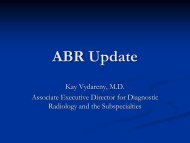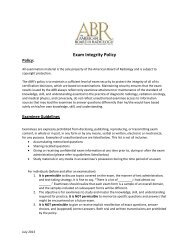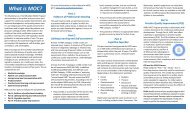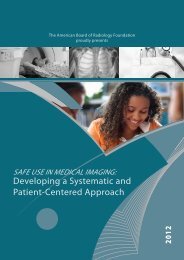ABR article on PQI for diagnostic radiologists - The American Board ...
ABR article on PQI for diagnostic radiologists - The American Board ...
ABR article on PQI for diagnostic radiologists - The American Board ...
You also want an ePaper? Increase the reach of your titles
YUMPU automatically turns print PDFs into web optimized ePapers that Google loves.
Strife et al.<br />
Maintenance of<br />
Certificati<strong>on</strong><br />
<strong>The</strong> Practice of Radiology • Perspective<br />
05_06_1540_Strife.fm — 3/1/07<br />
<strong>The</strong> <strong>American</strong> <strong>Board</strong> of Radiology<br />
Perspective <strong>on</strong> Maintenance of<br />
Certificati<strong>on</strong>: Part IV—Practice<br />
Quality Improvement in<br />
Diagnostic Radiology<br />
Janet L. Strife 1<br />
Larry E. Kun<br />
Gary J. Becker<br />
N. Reed Dunnick<br />
Jennifer Bosma<br />
Robert R. Hattery<br />
Strife JL, Kun LE, Becker GJ, Dunnick NR,<br />
Bosma J, Hattery RR<br />
This <str<strong>on</strong>g>article</str<strong>on</strong>g> is being published simultaneously in Radiology;<br />
RadioGraphics; Academic Radiology; the <strong>American</strong><br />
Journal of Roentgenology; and the Journal of the <strong>American</strong><br />
College of Radiology—Anth<strong>on</strong>y V. Proto, editor, Radiology.<br />
<strong>The</strong> authors have stated no financial relati<strong>on</strong>ships to<br />
disclose.<br />
Keywords: c<strong>on</strong>tinuing medical educati<strong>on</strong>, maintenance of<br />
certificati<strong>on</strong>, practice quality, radiology practice<br />
DOI:10.2214/AJR.06.1540<br />
Received November 21, 2006; accepted without revisi<strong>on</strong><br />
November 30, 2006.<br />
1 All authors: <strong>The</strong> <strong>American</strong> <strong>Board</strong> of Radiology,<br />
5441 E Williams Blvd., Tucs<strong>on</strong>, AZ 85711. Address<br />
corresp<strong>on</strong>dence to J. L. Strife.<br />
AJR 2007; 188:1–4<br />
0361–803X/07/1885–1<br />
© <strong>American</strong> Roentgen Ray Society<br />
he <strong>American</strong> public expects safe,<br />
T<br />
predictable, high-quality care and<br />
assumes that physicians work to<br />
remain current and competent. <strong>The</strong><br />
<strong>American</strong> <strong>Board</strong> of Radiology (<str<strong>on</strong>g>ABR</str<strong>on</strong>g>) encourages<br />
each board-certified <strong>diagnostic</strong> radiologist<br />
to understand his or her professi<strong>on</strong>al resp<strong>on</strong>sibilities<br />
and to participate in c<strong>on</strong>tinuous<br />
quality improvement and lifel<strong>on</strong>g learning.<br />
In the United States health care system, quality<br />
of care, medical error reducti<strong>on</strong>, and patient<br />
safety represent c<strong>on</strong>tinuing themes that dominate<br />
public c<strong>on</strong>cern [1–3]. Maintenance of Certificati<strong>on</strong><br />
(MOC), the overarching program of<br />
the <strong>American</strong> <strong>Board</strong> of Medical Specialties<br />
(ABMS) and its member boards, is the resp<strong>on</strong>se<br />
of U.S. physicians to address these c<strong>on</strong>cerns<br />
[4–8]. Although advances in medical science,<br />
technology, and biomedical research c<strong>on</strong>tinue<br />
to accelerate, other barriers prevent rapid disseminati<strong>on</strong><br />
and adopti<strong>on</strong> of evidence-based,<br />
recommended care [9]. A RAND Corporati<strong>on</strong><br />
study has estimated that <strong>on</strong>ly 50–54% of the<br />
care <strong>American</strong>s receive is care that has been recommended<br />
<strong>on</strong> the basis of evidence-based medical<br />
literature [3]. Much of what <strong>radiologists</strong> do<br />
is not evidence based [10]. Outcomes and costs<br />
to diagnose and treat specific diseases vary<br />
widely am<strong>on</strong>g physicians, hospitals, health care<br />
providers, and regi<strong>on</strong>s of the country [10].<br />
To address challenges in the medical system<br />
and the public’s c<strong>on</strong>cerns, the ABMS,<br />
composed of 24 member boards representing<br />
all medical subspecialties in the United<br />
States, mandated in March 2000 that each<br />
board initiate specialty-specific MOC programs<br />
[4–8]. Diplomates are no l<strong>on</strong>ger<br />
granted lifetime certificati<strong>on</strong> but rather must<br />
dem<strong>on</strong>strate evidence of professi<strong>on</strong>alism,<br />
c<strong>on</strong>tinuing medical educati<strong>on</strong> and knowledge,<br />
as well as a commitment to practice improvement.<br />
<strong>The</strong> MOC program, including<br />
“Part IV: Practice Quality Improvement,” <strong>for</strong><br />
<strong>diagnostic</strong> radiology, radiati<strong>on</strong> <strong>on</strong>cology, and<br />
radiologic physics has been developed, approved<br />
by the ABMS, and initiated in 2007.<br />
<strong>The</strong> overriding objective of MOC is to improve<br />
the quality of health care through diplomate-initiated<br />
learning and quality improvement.<br />
<strong>The</strong>re are four comp<strong>on</strong>ent parts to<br />
the MOC process: “Part I: Professi<strong>on</strong>al<br />
Standing,” “Part II: Lifel<strong>on</strong>g Learning and<br />
Periodic Self-Assessment,” “Part III, Cognitive<br />
Expertise,” and “Part IV: Evaluati<strong>on</strong> of<br />
Practice Per<strong>for</strong>mance” [11–15]. <strong>The</strong> <str<strong>on</strong>g>ABR</str<strong>on</strong>g><br />
program <strong>for</strong> self-evaluati<strong>on</strong> of practice per<strong>for</strong>mance<br />
is linked to a process of c<strong>on</strong>tinuing<br />
quality improvement and is titled “Practice<br />
Quality Improvement” (<strong>PQI</strong>).<br />
<strong>PQI</strong> Projects<br />
<strong>The</strong> key characteristics of <strong>PQI</strong> require each<br />
physician to dem<strong>on</strong>strate commitment to<br />
practice quality improvement and competence<br />
in clinical practice. How do we measure<br />
competence when practices are diverse and<br />
roles are unique How can we improve quality<br />
in the system in which we provide care<br />
<strong>The</strong> <str<strong>on</strong>g>ABR</str<strong>on</strong>g> guidelines state that every diplomate<br />
must select a project or projects that potentially<br />
can improve the quality of the diplomate’s<br />
practice and enhance quality of care.<br />
Key requirements <strong>for</strong> the <str<strong>on</strong>g>ABR</str<strong>on</strong>g>’s <strong>PQI</strong> program<br />
are that each project (a) be relevant to the diplomate’s<br />
practice, (b) be achievable in a practice<br />
setting, (c) produce measurable results<br />
that are suitable <strong>for</strong> repeated measurement<br />
over the course of the 10-year MOC cycle,<br />
and (d) be able to effect quality improvement.<br />
We anticipate that most <strong>PQI</strong> projects will include<br />
the majority or all of the six general<br />
competencies of medicine defined <strong>for</strong> training<br />
and practice: medical knowledge, patient<br />
care, interpers<strong>on</strong>al and communicati<strong>on</strong> skills,<br />
professi<strong>on</strong>alism, practice-based learning and<br />
improvement, and systems-based practice.<br />
A central element of <strong>PQI</strong> is to provide evidence<br />
of critical evaluati<strong>on</strong> of the individual’s<br />
AJR:188, May 2007 1
05_06_1540_Strife.fm — 3/1/07<br />
Strife et al.<br />
per<strong>for</strong>mance in practice. Clearly, the ultimate<br />
goals of each individual diplomate, as well as<br />
all diplomates collectively, must be to achieve<br />
<strong>on</strong>going improvement of practice and to dem<strong>on</strong>strate<br />
competency as a physician [6, 8, 16].<br />
Projects may be developed by the diplomates<br />
individually, by instituti<strong>on</strong>s or societies,<br />
or as a part of nati<strong>on</strong>al registries. At this<br />
juncture, because the <str<strong>on</strong>g>ABR</str<strong>on</strong>g> is just introducing<br />
part IV requirements, <strong>on</strong>ly failure to participate<br />
in a project or failure to comply with<br />
<str<strong>on</strong>g>ABR</str<strong>on</strong>g>’s reporting requirements will be c<strong>on</strong>sidered<br />
unsatisfactory per<strong>for</strong>mance. As diplomates<br />
become more familiar with quality improvement<br />
principles and their applicati<strong>on</strong>s to<br />
radiology practice, expectati<strong>on</strong>s <strong>for</strong> specific<br />
outcomes in the <strong>PQI</strong> project will be developed<br />
and articulated by the <str<strong>on</strong>g>ABR</str<strong>on</strong>g>.<br />
This communicati<strong>on</strong> addresses how diplomates<br />
participating in the <str<strong>on</strong>g>ABR</str<strong>on</strong>g> MOC program<br />
will use part IV (<strong>PQI</strong>) to dem<strong>on</strong>strate<br />
to patients, colleagues, and the broader<br />
health care community that they c<strong>on</strong>tinue to<br />
maintain the competencies of medicine previously<br />
menti<strong>on</strong>ed.<br />
In developing its program of part IV topics,<br />
the <str<strong>on</strong>g>ABR</str<strong>on</strong>g> faced the following major challenges:<br />
the diversity of radiology practices, including<br />
the full spectrum from generalist to subspecialist,<br />
active practiti<strong>on</strong>er to administrator, and direct<br />
patient caregiver to c<strong>on</strong>sultant; the full<br />
range of practice settings, from hospital to office<br />
based to both; the lack of a disease-specific<br />
focus in radiology; and the need to address and<br />
incorporate nati<strong>on</strong>al health care priorities.<br />
In an ef<strong>for</strong>t to meet these challenges, the<br />
<str<strong>on</strong>g>ABR</str<strong>on</strong>g> has created five categories from which an<br />
individual diplomate can select <strong>on</strong>e required<br />
<strong>PQI</strong> project: (a) patient safety, (b) accuracy of<br />
interpretati<strong>on</strong>, (c) report turnaround time, (d)<br />
practice guidelines and technical standards,<br />
and (e) referring physician surveys. <strong>The</strong> paragraphs<br />
that follow describe the rati<strong>on</strong>ale underlying<br />
each of these categories, c<strong>on</strong>crete examples<br />
of <strong>PQI</strong> projects that might be undertaken<br />
by an individual diplomate, and suggesti<strong>on</strong>s as<br />
to how nati<strong>on</strong>al or subspecialty societies could<br />
lend valuable aid to project development. A<br />
potential sec<strong>on</strong>dary gain is the producti<strong>on</strong> of<br />
nati<strong>on</strong>al data repositories, allowing individual<br />
diplomates to compare their per<strong>for</strong>mance with<br />
that of their colleagues.<br />
What is the timeline <strong>for</strong> participati<strong>on</strong> <strong>The</strong><br />
first year of a cycle should provide <strong>radiologists</strong><br />
the opportunity to learn about the <strong>PQI</strong> process<br />
and explore opti<strong>on</strong>s <strong>for</strong> participating in an assessment<br />
of their practices regarding improvement<br />
in the quality of care delivered. Each <strong>diagnostic</strong><br />
radiologist may select a project<br />
appropriate <strong>for</strong> an individual, participate in a<br />
project within a radiology department, or<br />
choose a qualified nati<strong>on</strong>al project sp<strong>on</strong>sored<br />
by a radiologic society. After selecting a<br />
project, the steps are (a) collect baseline data<br />
relevant to the chosen project, (b) review and<br />
analyze the data and develop an improvement<br />
plan, (c) remeasure and track, and (d) report<br />
participati<strong>on</strong> to the <str<strong>on</strong>g>ABR</str<strong>on</strong>g> using the template<br />
provided by the <str<strong>on</strong>g>ABR</str<strong>on</strong>g> (Table 1). <strong>The</strong> reporting<br />
requirements are satisfied by electr<strong>on</strong>ic entry<br />
into each diplomate’s password-protected <str<strong>on</strong>g>ABR</str<strong>on</strong>g><br />
Pers<strong>on</strong>al Database. <strong>The</strong> descripti<strong>on</strong>s below include<br />
a brief rati<strong>on</strong>ale and specific examples of<br />
the five areas targeted to improve quality of care<br />
in <strong>diagnostic</strong> radiology. This is a work in<br />
progress, and the examples here are provided to<br />
help the diplomate understand the process as it<br />
nears implementati<strong>on</strong>. Note that the minimum<br />
requirement is satisfactory completi<strong>on</strong> of <strong>on</strong>e<br />
<strong>PQI</strong> project per MOC cycle. If goals in a project<br />
are achieved readily, however, the diplomate<br />
will be encouraged to select and participate in<br />
another quality improvement project.<br />
TABLE 1: <strong>PQI</strong> Timeline and Milest<strong>on</strong>e<br />
Tracking <strong>for</strong> Diagnostic<br />
Radiology Diplomates<br />
Year of<br />
Cycle<br />
Task a<br />
1 Learn about <strong>PQI</strong> process<br />
Select project and metric(s)<br />
2 Collect baseline data<br />
3 Analyze the data<br />
Work <strong>on</strong> improvement plan<br />
4 Collect data, compare with initial data,<br />
summarize results<br />
5 Modify improvement plan<br />
6 Analyze data<br />
If goals achieved, select additi<strong>on</strong>al <strong>PQI</strong><br />
project<br />
7 Summarize data<br />
Refine improvement plan<br />
8 C<strong>on</strong>tinue collecting data<br />
9 Complete collecti<strong>on</strong> of improvement<br />
plan data<br />
Analyze data<br />
Summarize data<br />
10 Prepare final report of results and<br />
c<strong>on</strong>clusi<strong>on</strong>s<br />
Maintain gain of first cycle<br />
Select topic <strong>for</strong> next cycle<br />
a To be completed by diplomate in specified year of 10-<br />
year MOC cycle.<br />
Patient Safety<br />
All <strong>radiologists</strong> are c<strong>on</strong>cerned with the<br />
safety of the patients in their practices.<br />
Some examples of safety parameters that<br />
could be measured include radiati<strong>on</strong> dose<br />
(especially in vulnerable patient groups<br />
such as pediatric patients or women of<br />
child-bearing age), magnetic res<strong>on</strong>ance<br />
(MR) safety, hand washing, medicati<strong>on</strong> error<br />
preventi<strong>on</strong>, and others. Described below,<br />
as an example, is the safe use of<br />
iodinated c<strong>on</strong>trast material during interventi<strong>on</strong>al<br />
procedures.<br />
An example of a <strong>PQI</strong> project important to<br />
a large sector of <strong>diagnostic</strong> radiology is the<br />
“safe use of iodinated radiographic c<strong>on</strong>trast<br />
material.” <strong>The</strong> hypothetical best practice<br />
would include all of the following: (a) accurate<br />
history in 100% of patients in advance<br />
of scheduled procedure; (b) current serum<br />
creatinine value in patients with a history indicating<br />
renal disease; (c) selecti<strong>on</strong> of alternative<br />
procedures (e.g., MR, ultras<strong>on</strong>ography,<br />
or unenhanced computed tomography<br />
[CT] whenever appropriate); (d) intravenous<br />
hydrati<strong>on</strong>, c<strong>on</strong>trast dose adjustment, or<br />
other medical management in patients who<br />
have a high risk of c<strong>on</strong>trast agent–induced<br />
nephropathy and who must nevertheless undergo<br />
the iodinated c<strong>on</strong>trast-enhanced procedure;<br />
(e) corticosteroid premedicati<strong>on</strong> in<br />
patients at increased risk of severe idiosyncratic<br />
c<strong>on</strong>trast agent reacti<strong>on</strong>; (f) presence<br />
of a physician available during the procedure<br />
and of pers<strong>on</strong>nel trained in the management<br />
of severe idiosyncratic c<strong>on</strong>trast agent<br />
reacti<strong>on</strong>s; (g) accessible inventoried crash<br />
cart in the vicinity, with its date of inventory;<br />
and (i) proper management of all c<strong>on</strong>trast<br />
agent reacti<strong>on</strong>s that occur, with documentati<strong>on</strong><br />
of that management.<br />
Individual patient encounter records<br />
should indicate whether the best practice<br />
outlined above was met. Patient identifying<br />
in<strong>for</strong>mati<strong>on</strong>, date, type of procedure, and<br />
clinical indicati<strong>on</strong> <strong>for</strong> the procedure should<br />
be recorded <strong>for</strong> the purpose of data retrieval.<br />
<strong>The</strong> completed data sheets <strong>on</strong> each patient in<br />
the baseline cohort should be tallied. <strong>The</strong> final<br />
baseline report should indicate the number<br />
of times best practice <strong>for</strong> safe use of iodinated<br />
c<strong>on</strong>trast media was met.<br />
After the baseline data are gathered and<br />
the per<strong>for</strong>mance improvement opportunities<br />
are identified, the per<strong>for</strong>mance improvement<br />
plan must be crafted. Once the plan is implemented,<br />
the diplomate simply follows the<br />
<strong>PQI</strong> template (Table 1).<br />
2 AJR:188, May 2007
05_06_1540_Strife.fm — 3/1/07<br />
Maintenance of Certificati<strong>on</strong><br />
Accuracy of Interpretati<strong>on</strong><br />
Another characteristic of competent <strong>radiologists</strong><br />
is that their interpretati<strong>on</strong>s have a high degree<br />
of accuracy. A <strong>PQI</strong> project in this category<br />
should be easily implemented and generate results<br />
suitable <strong>for</strong> entry into a local or nati<strong>on</strong>al<br />
registry <strong>for</strong> comparis<strong>on</strong> with other <strong>radiologists</strong>.<br />
One c<strong>on</strong>crete example of such a project is double<br />
reading of selected examinati<strong>on</strong>s.<br />
A double reading project can be per<strong>for</strong>med<br />
in a variety of ways. A radiologist could compare<br />
his or her readings with those of other <strong>radiologists</strong><br />
in the practice, compare the rendered<br />
diagnosis with the results of pathologic<br />
evaluati<strong>on</strong>, or review a series of reference imaging<br />
studies presented as unknowns. <strong>The</strong><br />
purpose of comparis<strong>on</strong> of dictated results<br />
with those of colleagues viewing the same<br />
cases is to benchmark dictated reports and <strong>diagnostic</strong><br />
impressi<strong>on</strong>s. Follow-up double reading<br />
studies should show a decrease in observed<br />
errors, missed findings, or reduced<br />
number of changes in interpretati<strong>on</strong>.<br />
A project studying accuracy of interpretati<strong>on</strong><br />
should include such metrics as the error<br />
rate, an analysis of root causes of those errors,<br />
and a plan to minimize the errors identified in<br />
the project. In additi<strong>on</strong>, such a project should<br />
quantify not <strong>on</strong>ly the number of changes in interpretati<strong>on</strong><br />
by the sec<strong>on</strong>d reader but also the<br />
significance of those changes. Projects in this<br />
category could be designed by individual diplomates<br />
or by professi<strong>on</strong>al societies.<br />
RADPEER is <strong>on</strong>e example of a project to<br />
study accuracy of interpretati<strong>on</strong>. It was established<br />
by the <strong>American</strong> College of Radiology<br />
(ACR) and fulfills the standards listed above.<br />
This project allows a study of c<strong>on</strong>currence<br />
and error rate by radiologist, facility, and modality.<br />
Error severity and impact can be analyzed<br />
through the peer review committee input,<br />
as suggested by the RADPEER project.<br />
This program is part of the Nati<strong>on</strong>al Radiology<br />
Data Registry (NRDR).<br />
Report Turnaround Time<br />
Referring physicians act <strong>on</strong> interpretati<strong>on</strong>s,<br />
and they utilize the final imaging report to help<br />
them care <strong>for</strong> their patients. Thus, it is important<br />
to provide <strong>diagnostic</strong> interpretati<strong>on</strong> in a<br />
timely fashi<strong>on</strong>. <strong>The</strong> times that are appropriate<br />
<strong>for</strong> these radiology reports vary with the clinical<br />
setting. For example, different report times<br />
are appropriate <strong>for</strong> patients seen in the emergency<br />
room, <strong>for</strong> inpatients, <strong>for</strong> outpatients, and<br />
<strong>for</strong> those undergoing screening examinati<strong>on</strong>s.<br />
<strong>The</strong> report time is defined as the time between<br />
completi<strong>on</strong> of the examinati<strong>on</strong> and the<br />
time when the final report is made available to<br />
the referring physician. Increasingly, examinati<strong>on</strong>s<br />
are electr<strong>on</strong>ically reported, which<br />
makes collecti<strong>on</strong> of such data practical.<br />
A <strong>PQI</strong> project <strong>on</strong> report times would include<br />
collecti<strong>on</strong> of baseline data <strong>for</strong> the individual<br />
radiologist. A plan to improve the report<br />
times should then be prepared in written<br />
<strong>for</strong>m and should describe measures to improve<br />
the per<strong>for</strong>mance. <strong>The</strong>n, data should be<br />
collected a sec<strong>on</strong>d time, approximately 3<br />
years after the first data set. A sec<strong>on</strong>d improvement<br />
plan should then be developed <strong>on</strong><br />
the basis of the results evident in the sec<strong>on</strong>d<br />
data collecti<strong>on</strong>. This leads to a third data collecti<strong>on</strong><br />
interval after another 2–3 years.<br />
Practice Guidelines and<br />
Technical Standards<br />
Choosing this <strong>PQI</strong> category requires that<br />
the diplomate select two projects: One must<br />
involve the ACR communicati<strong>on</strong> guideline;<br />
the other may be based up<strong>on</strong> any of the 91<br />
practice guidelines and six technical standards<br />
available through ACR publicati<strong>on</strong>s or<br />
the ACR Web site (www.acr.org).<br />
Communicati<strong>on</strong> Project<br />
Competent <strong>radiologists</strong> are capable clinicians<br />
whose c<strong>on</strong>tributi<strong>on</strong> to patient care includes<br />
communicating the results of radiologic<br />
examinati<strong>on</strong>s to the appropriate individuals in a<br />
timely manner. Accordingly, the ACR practice<br />
guideline <strong>on</strong> communicati<strong>on</strong> states, “When a<br />
study discovers findings that reflect a diagnosis<br />
that seriously impacts the patient’s health, a direct<br />
communicati<strong>on</strong> to the caring physician is<br />
mandatory and should also be documented in<br />
the final report.”<br />
As a c<strong>on</strong>crete example, the radiologist<br />
could review a c<strong>on</strong>secutive series of recent reports<br />
to determine how often unexpected results<br />
were detected and communicated to the<br />
appropriate physician at the time of the examinati<strong>on</strong><br />
and how often communicati<strong>on</strong> was<br />
documented in the final written report. On the<br />
basis of the analysis of the initial study, an improvement<br />
plan could be developed. Subsequently,<br />
in a different year, review of another<br />
c<strong>on</strong>secutive series of reports could be compared<br />
with the initial study, and improvement<br />
in per<strong>for</strong>mance will hopefully be noted.<br />
Practice Guideline and<br />
Technical Standards Project<br />
Diplomates choosing this category of <strong>PQI</strong><br />
project must also select another project that<br />
deals with any of the other practice guidelines<br />
or technical standards. As an example, a radiologist<br />
who per<strong>for</strong>ms CT of the abdomen and<br />
pelvis could review a series of c<strong>on</strong>secutive<br />
cases from recent practice to determine how<br />
much (what percentage) of the small or large<br />
intestine was adequately filled with oral c<strong>on</strong>trast<br />
material.<br />
For each practice guideline, after analysis<br />
of the results a plan is <strong>for</strong>mulated <strong>for</strong> improvement.<br />
Subsequently, a sec<strong>on</strong>d data collecti<strong>on</strong><br />
period helps determine the effectiveness<br />
of this plan (Table 1).<br />
Referring Physician Surveys<br />
Patient treatment is usually directed by the<br />
referring physician. <strong>The</strong> radiologist c<strong>on</strong>tributes<br />
to care of the patient by helping the referring<br />
physician request the most appropriate<br />
examinati<strong>on</strong>, providing timely patient access<br />
to imaging, per<strong>for</strong>ming the examinati<strong>on</strong><br />
safely, interpreting the study accurately, and<br />
reporting the findings promptly. <strong>The</strong> experience<br />
of the referring physicians’ interacti<strong>on</strong>s<br />
with the radiologist can be assessed through<br />
surveys of those referring physicians.<br />
Referring physician surveys must be qualified<br />
by the <str<strong>on</strong>g>ABR</str<strong>on</strong>g>. A few example surveys, either<br />
developed by the <str<strong>on</strong>g>ABR</str<strong>on</strong>g> or modified from<br />
the CAHPS (C<strong>on</strong>sumer Assessment of<br />
Healthcare Providers and Systems) survey,<br />
are available <strong>on</strong> the <str<strong>on</strong>g>ABR</str<strong>on</strong>g> Web site. <strong>The</strong> survey<br />
must include the following parameters:<br />
accessibility of the radiologist <strong>for</strong> examinati<strong>on</strong>s<br />
or procedures, resp<strong>on</strong>siveness <strong>for</strong> urgent<br />
examinati<strong>on</strong> c<strong>on</strong>sultati<strong>on</strong>, professi<strong>on</strong>alism,<br />
report turnaround time, and satisfacti<strong>on</strong> of the<br />
referring physician with his or her interacti<strong>on</strong>.<br />
As with other projects, analysis of the resp<strong>on</strong>ses<br />
must lead to an improvement plan,<br />
which, after initiati<strong>on</strong>, should be evaluated by<br />
using the same survey instrument after a suitable<br />
time period.<br />
<strong>The</strong> <str<strong>on</strong>g>ABR</str<strong>on</strong>g> and MOC<br />
Dramatic change has occurred in the relati<strong>on</strong>ship<br />
of the diplomate to the <str<strong>on</strong>g>ABR</str<strong>on</strong>g>. In the<br />
past, interacti<strong>on</strong> occurred <strong>on</strong>ly in residency<br />
<strong>for</strong> the three examinati<strong>on</strong>s: physics, clinical,<br />
and oral. Now, the relati<strong>on</strong>ship between a <strong>diagnostic</strong><br />
radiologist and the <str<strong>on</strong>g>ABR</str<strong>on</strong>g> will begin<br />
in residency and be c<strong>on</strong>tinuous throughout his<br />
or her professi<strong>on</strong>al life. <strong>The</strong> lifetime relati<strong>on</strong>ship<br />
will be maintained through frequent<br />
electr<strong>on</strong>ic communicati<strong>on</strong> of MOC updates,<br />
key milest<strong>on</strong>es c<strong>on</strong>cerning the diplomate’s<br />
progress through the MOC cycle, and reminders<br />
to increase activity whenever the diplomate<br />
is falling behind.<br />
AJR:188, May 2007 3
05_06_1540_Strife.fm — 3/1/07<br />
Strife et al.<br />
Trans<strong>for</strong>mati<strong>on</strong> of the<br />
<str<strong>on</strong>g>ABR</str<strong>on</strong>g> Infrastructure<br />
<strong>The</strong> <str<strong>on</strong>g>ABR</str<strong>on</strong>g> is committed to providing a Webbased<br />
system <strong>for</strong> diplomates to use both to access<br />
current in<strong>for</strong>mati<strong>on</strong> about maintenance of<br />
certificati<strong>on</strong> requirements and to record<br />
progress. <strong>The</strong> <str<strong>on</strong>g>ABR</str<strong>on</strong>g> Web site enables diplomates<br />
to access specialty-specific in<strong>for</strong>mati<strong>on</strong> and resources<br />
about MOC: the four comp<strong>on</strong>ents; the<br />
six competencies; and all requirements, examinati<strong>on</strong>s,<br />
and fees. <strong>The</strong> password-protected <str<strong>on</strong>g>ABR</str<strong>on</strong>g><br />
Pers<strong>on</strong>al Database is each diplomate’s center <strong>for</strong><br />
pers<strong>on</strong>alized in<strong>for</strong>mati<strong>on</strong> about MOC requirements<br />
and <strong>for</strong> tracking and documenting MOC<br />
progress. Within his or her pers<strong>on</strong>al database, the<br />
individual will be able to record participati<strong>on</strong> in<br />
educati<strong>on</strong>al activities; attest to the fulfillment of<br />
various requirements, such as participati<strong>on</strong> in<br />
<strong>PQI</strong> projects; update pers<strong>on</strong>al in<strong>for</strong>mati<strong>on</strong>; pay<br />
fees; and register <strong>for</strong> examinati<strong>on</strong>s.<br />
Future plans call <strong>for</strong> linkages between the<br />
<str<strong>on</strong>g>ABR</str<strong>on</strong>g> and societies sp<strong>on</strong>soring c<strong>on</strong>tinuing<br />
medical educati<strong>on</strong> (CME) credit, self-assessment<br />
modules (SAMs), and <strong>PQI</strong> projects.<br />
<strong>The</strong>se linkages, undertaken with permissi<strong>on</strong><br />
of the society and the individual diplomate,<br />
will allow the transmissi<strong>on</strong> of credits and <strong>PQI</strong><br />
participati<strong>on</strong> directly into the individual’s<br />
<str<strong>on</strong>g>ABR</str<strong>on</strong>g> Pers<strong>on</strong>al Database. <strong>The</strong>se entries will be<br />
regarded by the <str<strong>on</strong>g>ABR</str<strong>on</strong>g> as authenticated in the<br />
case of an audit, and no further documentati<strong>on</strong><br />
will be required.<br />
<strong>The</strong> Role of Subspecialty Societies<br />
Both the broad-based and the subspecialty<br />
radiology societies play a very important role,<br />
serving their members by advancing the science<br />
and practice of their subspecialty and in<strong>for</strong>ming<br />
them <strong>on</strong> regi<strong>on</strong>al and nati<strong>on</strong>al issues<br />
relevant to their practice. <strong>The</strong> societies know<br />
the key comp<strong>on</strong>ents of their practices and<br />
stimulate the promoti<strong>on</strong> of quality in practice.<br />
<strong>The</strong>ir multiple and potentially expanded roles<br />
include, but are not limited to, educati<strong>on</strong>al<br />
courses or SAMs c<strong>on</strong>cerning <strong>PQI</strong>, workshops<br />
<strong>on</strong> subtopics of <strong>PQI</strong>, identificati<strong>on</strong> of key <strong>PQI</strong><br />
focus areas and potential metrics, and the development<br />
of tools or project templates <strong>for</strong><br />
society members.<br />
Development of nati<strong>on</strong>al databases related<br />
to practice parameters in <strong>diagnostic</strong> radiology<br />
is an important future goal in collecting <strong>PQI</strong><br />
data, and professi<strong>on</strong>al societies may play an<br />
active role in identifying key issues and providing<br />
templates <strong>for</strong> data collecti<strong>on</strong>. Nati<strong>on</strong>al<br />
databases of practice parameters are a valuable<br />
tool in optimizing the practice of medicine<br />
<strong>for</strong> our patients because they allow each<br />
radiologist to compare his or her results with<br />
those collected in similar practices throughout<br />
the country. <strong>The</strong> need <strong>for</strong> pooled, aggregate<br />
data <strong>on</strong> <strong>PQI</strong> results represents an opportunity<br />
<strong>for</strong> collaborati<strong>on</strong> am<strong>on</strong>g the many<br />
radiologic societies to establish nati<strong>on</strong>al databases<br />
<strong>for</strong> the benefit of our patients, our specialty,<br />
and all of medicine.<br />
Summary<br />
<strong>The</strong>re is a nati<strong>on</strong>al imperative to improve<br />
the quality and safety of health care. For <strong>radiologists</strong>,<br />
participati<strong>on</strong> in the <str<strong>on</strong>g>ABR</str<strong>on</strong>g>’s MOC<br />
<strong>PQI</strong> projects is a vehicle through which this<br />
can happen. We must measure what we do,<br />
provide comparative data, and encourage<br />
standardizati<strong>on</strong> of practice comp<strong>on</strong>ents to<br />
work toward improving the quality of care.<br />
Radiology has lagged behind some of the<br />
other specialties in measuring what we do<br />
and documenting our impact <strong>on</strong> clinical<br />
care. <strong>The</strong> <str<strong>on</strong>g>ABR</str<strong>on</strong>g> <strong>PQI</strong> program is a work in<br />
progress. C<strong>on</strong>siderable progress has been<br />
made in understanding our charge and identifying<br />
ways to use comm<strong>on</strong> practice metrics<br />
to enhance the individual’s practice of radiology,<br />
yet, change should be anticipated. As<br />
our evidence base grows, our <strong>PQI</strong> ef<strong>for</strong>ts<br />
will be improved and refined. We encourage<br />
active participati<strong>on</strong> of all certified <strong>radiologists</strong>,<br />
both those with time-limited certificates<br />
and those with lifetime certificates. We<br />
believe that most <strong>radiologists</strong> want to engage<br />
in a pers<strong>on</strong>ally and professi<strong>on</strong>ally rewarding,<br />
publicly visible process <strong>for</strong> <strong>on</strong>going<br />
quality improvement.<br />
References<br />
1. Kohn LT, Corrigan JM, D<strong>on</strong>alds<strong>on</strong> MS, eds. To err<br />
is human: building a safer health system. Washingt<strong>on</strong>,<br />
DC: Nati<strong>on</strong>al Academies Press, 2000<br />
2. Committee <strong>on</strong> Quality of Health Care in<br />
America, Institute of Medicine. Crossing the<br />
quality chasm: a new health system <strong>for</strong> the 21st<br />
century. Washingt<strong>on</strong>, DC: Nati<strong>on</strong>al Academies<br />
Press, 2001<br />
3. McGlynn EA, Asch SM, Adams J, et al. <strong>The</strong> quality<br />
of health care delivered to adults in the United<br />
States. N Engl J Med 2003; 348:2635–2645<br />
4. Miller SH. ABMS’ Maintenance of Certificati<strong>on</strong>:<br />
the challenge of c<strong>on</strong>tinuing competence. Clin Orthop<br />
Relat Res 2006; 449:155–158<br />
5. Cassel CK, Holmboe ES. Credentialing and public<br />
accountability: a central role <strong>for</strong> board certificati<strong>on</strong>.<br />
JAMA 2006; 295:939–940<br />
6. Brennan TA, Horwitz RI, Duffy FD, Cassel CK<br />
Goode LD, Lipner RS. <strong>The</strong> role of physician specialty<br />
board certificati<strong>on</strong> status in the quality movement.<br />
JAMA 2004; 292:1038–1043<br />
7. <strong>American</strong> <strong>Board</strong> of Medical Specialties. Initiatives<br />
recommended by the ABMS Task Force <strong>on</strong> Competence:<br />
descripti<strong>on</strong> of the competent physician.<br />
Evanst<strong>on</strong>, IL: <strong>American</strong> <strong>Board</strong> of Medical Specialties,<br />
1999<br />
8. Steinbrook R. Renewing board certificati<strong>on</strong>. N Engl<br />
J Med 2005; 353:1994–1997<br />
9. Rosenberg RN. Translating biomedical research to<br />
the bedside: a nati<strong>on</strong>al crisis and a call to acti<strong>on</strong>.<br />
JAMA 2003; 289:1305–1306<br />
10. Swens<strong>on</strong> SJ, Johns<strong>on</strong> CD. Radiologic quality and<br />
safety: mapping value into radiology. J Am Coll Radiol<br />
2005; 2:992–1000<br />
11. Madewell JE, Hattery RR, Thomas SR, et al. Maintenance<br />
of certificati<strong>on</strong>. AJR 2005; 184:3–10<br />
12. Madewell JE, Hattery RR, Thomas SR, et al. <strong>American</strong><br />
<strong>Board</strong> of Radiology: maintenance of certificati<strong>on</strong>.<br />
Radiology 2005; 234:17–25<br />
13. Madewell JE, Hattery RR, Thomas SR, et al. <strong>American</strong><br />
<strong>Board</strong> of Radiology: maintenance of certificati<strong>on</strong>.<br />
Acad Radiol 2005; 12:104–115<br />
14. Madewell JE, Hattery RR, Thomas SR, et al. <strong>American</strong><br />
<strong>Board</strong> of Radiology: maintenance of certificati<strong>on</strong>.<br />
RadioGraphics 2005; 25:285–296<br />
15. Madewell JE, Hattery RR, Thomas SR, et al. Maintenance<br />
of certificati<strong>on</strong>. J Am Coll Radiol 2005;<br />
2:22–32<br />
16. Bar<strong>on</strong> RJ. Pers<strong>on</strong>al metrics <strong>for</strong> practice: how’m I<br />
doing N Engl J Med 2005; 353:1992–1993<br />
4 AJR:188, May 2007



